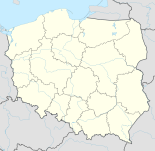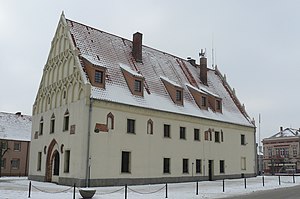Trzcińsko-Zdrój
| Trzcińsko-Zdrój | ||
|---|---|---|

|
|
|
| Basic data | ||
| State : | Poland | |
| Voivodeship : | West Pomerania | |
| Powiat : | Gryfino | |
| Gmina : | Trzcińsko-Zdrój | |
| Area : | 16.04 km² | |
| Geographic location : | 52 ° 58 ' N , 14 ° 37' E | |
| Residents : | 2263 (Jun. 30, 2019) |
|
| Postal code : | 74-510 | |
| Telephone code : | (+48) 91 | |
| License plate : | ZGR | |
| Economy and Transport | ||
| Street : | DK 26 : ( Germany– ) Krajnik Dolny ↔ Renice | |
| Rail route : | Szczecin – Wroclaw , train station: Chojna (12 km) | |
| Next international airport : | Szczecin-Goleniów | |
| Gmina | ||
| Gminatype: | Urban and rural municipality | |
| Gmina structure: | 22 villages | |
| 12 school offices | ||
| Surface: | 170.34 km² | |
| Residents: | 5313 (Jun. 30, 2019) |
|
| Population density : | 31 inhabitants / km² | |
| Community number ( GUS ): | 3206083 | |
| Administration (as of 2013) | ||
| Mayor : | Zbigniew Kitlas | |
| Address: | ul.Rynek 15 74-510 Trzcińsko-Zdrój |
|
| Website : | www.trzcinsko-zdroj.pl | |
Trzcińsko-Zdrój ( German : Bad Schönfließ ) is a small town with an urban and rural municipality in the Polish West Pomeranian Voivodeship . It belongs to the Powiat Gryfiński ( Greifenhagen district ) and has about 2,260 inhabitants.
Geographical location
The city is located in the Neumark on the river Rörike, about 25 kilometers southeast of Schwedt / Oder and 80 kilometers south of Stettin ( Szczecin ). The surrounding landscape is characterized by a chain of small lakes that extend north and south of the city.
history
In the old town there was probably a Slavic settlement on the trade routes Posen - Zantoch and Soldin - Königsberg (Neumark) . In 1281 the village came under the name Schowenfliet to Brandenburg . In the 14th century the place was granted the right to export grain, hold markets and be exempt from customs duties.
In 1433 the Hussites ravaged the city. It suffered severe damage during the Thirty Years' War . In 1870 large parts of the city's fortifications were demolished and converted into parks.
At the end of the 19th century, Schönfließ became a bathing resort (mud bath), and in 1907 it was given the title “ Bad ”. The city survived the Second World War without much destruction.
Until 1945 Bad Schönfließ was part of the Königsberg Nm district. in the administrative district of Frankfurt in the province of Brandenburg .
Towards the end of the Second World War , the Red Army occupied the city in the spring of 1945 . After the end of the war, Bad Schönfließ was placed under Polish administration by the Soviet Union . This was followed by the immigration of Polish migrants, some of whom came from areas east of the Curzon Line conquered by Poland after the First World War . The city now received the Polish name Trzcińsko-Zdrój . In the following period, the local population was expelled by the local Polish administrative authority .
Today the city is the seat of Gmina of the same name in the West Pomeranian Voivodeship (until 1998 Szczecin Voivodeship ).
Rohrbeck manor around 1860, Alexander Duncker collection
Demographics
| year | Residents | Remarks |
|---|---|---|
| 1719 | 1200 | |
| 1750 | 1448 | |
| 1800 | 1712 | including 90 Jews (ten families) |
| 1840 | 2296 | |
| 1850 | 2566 | including five Catholics and 101 Jews |
| 1858 | 2728 | including ten Catholics and 109 Jews |
| 1867 | 2946 | on December 3rd |
| 1871 | 3051 | on December 1st, including 3260 Protestants, 26 Catholics, 71 Jews |
| 1875 | 2995 | |
| 1880 | 3149 | |
| 1905 | 2593 | mostly evangelicals |
| 1933 | 2854 | |
| 1939 | 2644 |
traffic
The country road 26 ( droga krajowa 26 ) leads to the place, which connects it with the neighboring towns of Königsberg in the Neumark ( Chojna ) and Soldin ( Myślibórz ).
sons and daughters of the town
- Wilhelm Liebenow (1822–1897), topographer and cartographer
- Paul Billerbeck (1853–1932), theologian and scientist
Gmina Trzcińsko-Zdrój
General
The town of Trzcińsko-Zdrój is the seat of the town and country municipality of the same name, which extends over an area of 170.34 km² and has almost 6000 inhabitants. At Trzcińsko Zdrój the river Rurzyca ( Röhrike ) rises , which runs through the municipality in a northerly direction and flows into the Oder . In the district of Góralice ( Görlsdorf ) rises the Tywa ( Thue ), which runs through the municipality in a westerly direction and flows into the Regalica ( Reglitz ).
The municipality has a single zip code: 74-510.
Neighboring communities are:
- Banie ( Bahn ), Chojna ( Königsberg in the Neumark ) and Mieszkowice ( Bärwalde ) in the Powiat Gryfiński ( Greifenhagen district ) as well
- Dębno ( Neudamm ) and Myślibórz ( Soldin ) in the powiat Myśliborski ( Soldin County ).
Community structure
The municipality is divided into 12 districts , into which 22 localities are integrated:
- Districts (Schulzenämter)
- Chełm Górny ( Hohenwartenberg )
- Dobropole ( Dobberphul )
- Gogolice ( Scharsendorf )
- Góralice ( Görlsdorf )
- Górczyn ( enclosure )
- Klasztorne ( Steineck )
- Piaseczno ( Pätzig )
- Rosnowo ( Rohrbeck )
- Stołeczna ( Stolzenfelde )
- Strzeszów ( Stresow )
- Tchórzno ( Theeren )
- Trzcińsko Zdrój ( Schönfließ Spa )
- Other localities
- Antoniewice ( Wernersfelde )
- Babin ( Gut Babin )
- Chełm Dolny ( Wartenberg )
- Cieplikowo ( sand pitcher )
- Czyst ( Weissensee )
- Drzesz ( Falkenthal )
- Głębokie ( Gerlachshoop )
- Osiecze ( Neuhof )
- Ostrzewka ( Prussian Windmill )
- Rosnówko ( Agneshof )
- Smuga ( Neidfeld )
- Szarpatki ( Engelke's brickworks )
- Wesoła ( Vorwerk Schönlinde )
traffic
Street
The Gmina Trzcińsko-Zdrój is located on the Polish state road 26 , which leads from the German border at Schwedt / Oder (connection: Bundesstraße 166 ) via Chojna or Myślibórz to Renice ( Rehnitz ) on state road 3 and the western Neumark with the so important road connects.
rail
The municipality has been decoupled from the railway network since 1992 after the state railway line Pyrzyce ( Pyritz ) –Godków ( Jädickendorf ) was closed. In addition to Trzcińsko-Zdrój, the districts of Góralice ( Görlsdorf ) and Rosnowo ( Rohrbeck ) were railway stations on this line. The nearest train station is in Chojna ( Königsberg in der Neumark ) on the important north-south route from Szczecin to Wroclaw .
literature
- Friedrich Wilhelm August Bratring : Statistical-topographical description of the entire Mark Brandenburg . Volume 3, Berlin 1809, pp. 100-102 .
- Heinrich Berghaus : Land book of the Mark Brandenburg and the Margraviate Nieder-Lausitz in the middle of the 19th century . Volume 3, 1st edition, Brandenburg 1856, pp. 402–404.
- W. Riehl and J. Scheu (eds.): Berlin and the Mark Brandenburg with the Margraviate Nieder-Lausitz in their history and in their present existence . Berlin 1861, pp. 413-415.
Web links
Footnotes
- ↑ a b population. Size and Structure by Territorial Division. As of June 30, 2019. Główny Urząd Statystyczny (GUS) (PDF files; 0.99 MiB), accessed December 24, 2019 .
- ↑ a b c d W. Riehl and J. Scheu (eds.): Berlin and the Mark Brandenburg with the Margraviate of Nieder-Lausitz in their history and in their current existence . Berlin 1861, pp. 413-415.
- ^ A b Heinrich Berghaus : Land book of the Mark Brandenburg and the Margrave of Lower Lusatia in the middle of the 19th century . Volume 3, 1st edition, Brandenburg 1856, pp. 402–404.
- ↑ a b Royal Statistical Bureau: The communities and manor districts of the Prussian state and their population . Part II: Province of Brandenburg , Berlin 1873, pp. 118–119, No. 7 ( online ).
- ↑ a b c d Michael Rademacher: German administrative history from the unification of the Reich in 1871 to the reunification in 1990. koenigsberg_n.html # ew39kbnm6schbad. (Online material for the dissertation, Osnabrück 2006).
- ^ Meyer's Large Conversational Lexicon . 6th edition, Volume 18, Leipzig / Vienna 1909, p. 3 ( online ).










